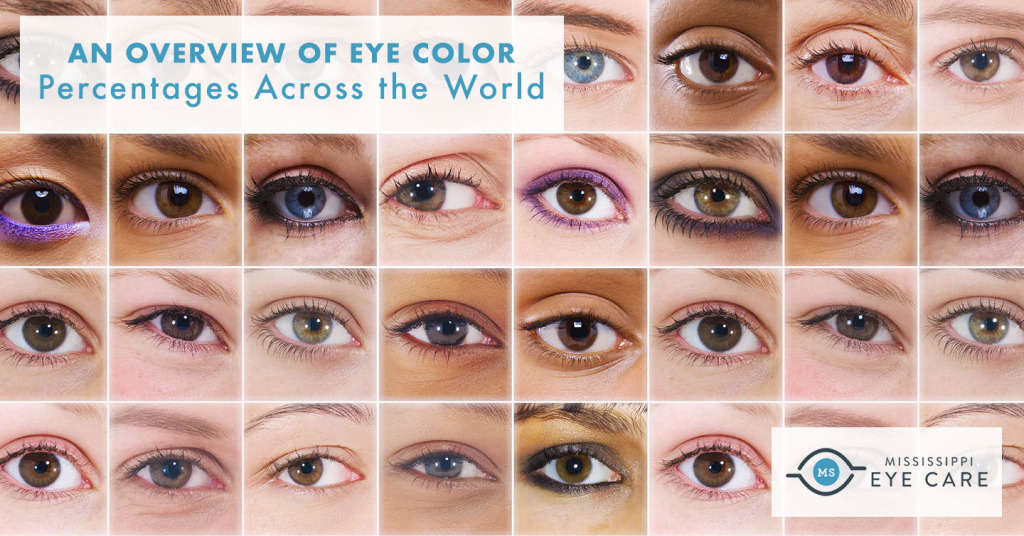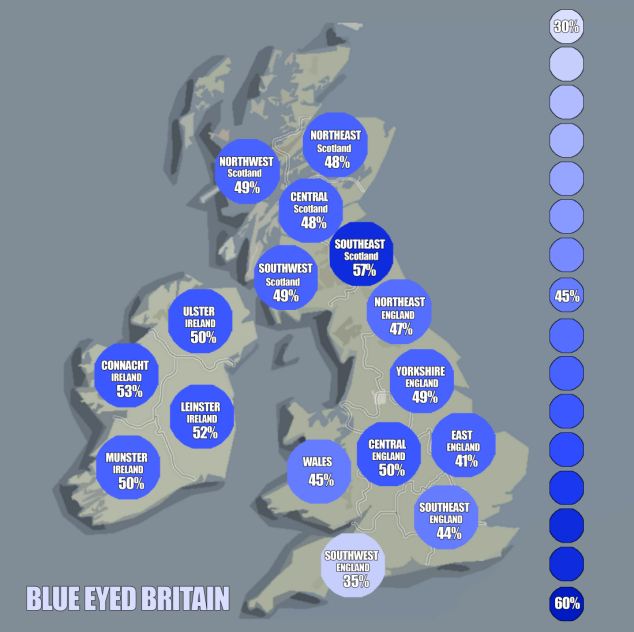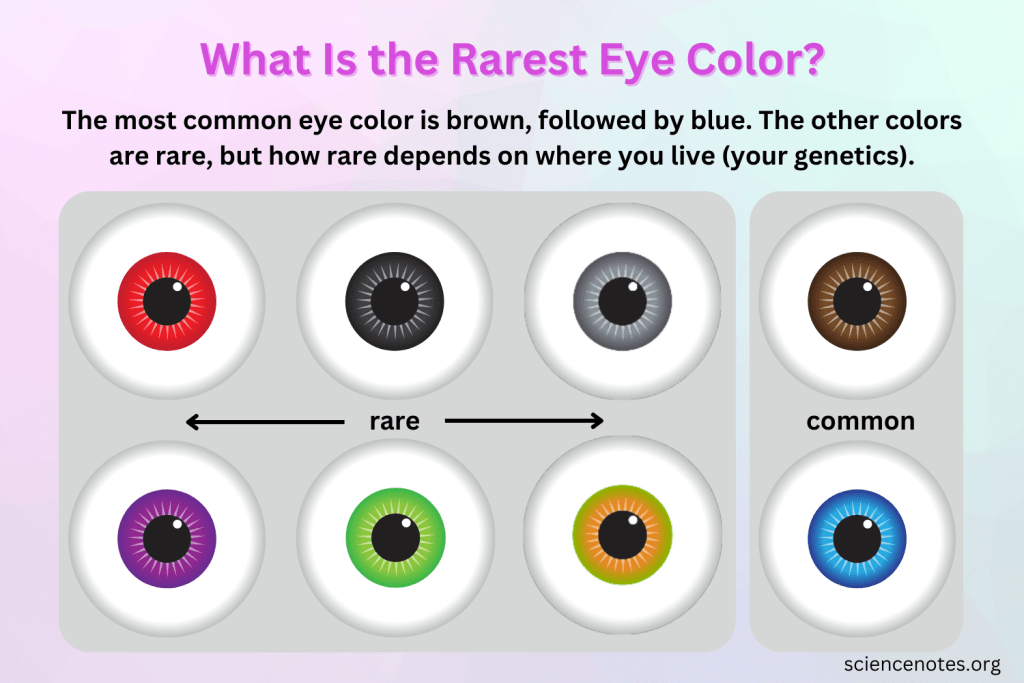The "most common eye color in Ireland" refers to the predominant shade of irises observed among the Irish population. For example, research indicates that hazel eyes, a combination of green and brown, hold the highest frequency in Ireland.
Understanding the most common eye color in Ireland holds cultural significance, offers insights into genetic diversity, and traces ancestral origins. Historically, hazel eyes have been associated with Celtic ancestry in Ireland.
This article delves into the prevalence, genetic factors, and cultural implications surrounding the most common eye color in Ireland, providing a comprehensive analysis of this intriguing aspect of the nation's identity.
Most Common Eye Color in Ireland
Understanding the most common eye color in Ireland involves examining several key aspects, each contributing to the unique characteristics of the Irish population.
- Genetic Predisposition
- Cultural Heritage
- Migration Patterns
- Environmental Factors
- Historical Influences
- Regional Variations
- Genetic Diversity
- Phenotypic Expression
These aspects are intertwined, shaping the prevalence and distribution of eye colors in Ireland. For instance, genetic predisposition plays a significant role, with certain gene variants associated with hazel eyes being more common among Irish individuals. Cultural heritage, influenced by Celtic ancestry, has also contributed to the prominence of hazel eyes. Furthermore, migration patterns throughout history have introduced diverse eye colors, adding to the genetic makeup of the Irish population.
Genetic Predisposition
Genetic predisposition is a central aspect influencing the most common eye color in Ireland. Inherited genetic variations play a significant role in determining eye color, with hazel eyes being the most prevalent in Ireland due to the widespread presence of specific gene variants.
- Gene Variants: Variations in the OCA2 and HERC2 genes are associated with hazel and blue eyes, respectively. These genes regulate the production and distribution of melanin, the pigment responsible for eye color.
- Population Genetics: The high frequency of hazel eyes in Ireland can be attributed to the genetic makeup of the Irish population, shaped by historical migrations and genetic drift.
- Ancestral Origins: The prevalence of hazel eyes is often linked to Celtic ancestry, as this eye color is common among Celtic populations in Ireland and other regions of Europe.
- Phenotypic Expression: Genetic predisposition interacts with environmental factors to influence eye color expression. For instance, exposure to sunlight can enhance melanin production, potentially darkening eye color.
Understanding genetic predisposition helps explain the prevalence of hazel eyes in Ireland and provides insights into the genetic diversity and ancestral heritage of the Irish population.
Cultural Heritage
Cultural heritage plays a significant role in shaping the most common eye color in Ireland. The prevalence of hazel eyes in the Irish population can be attributed, in part, to the nation's Celtic ancestry. Historically, the Celts, an ancient people who inhabited Ireland, had a high frequency of hazel eyes. This genetic legacy continues to influence the eye color distribution in Ireland today.
Beyond ancestry, cultural heritage also encompasses shared beliefs, values, and traditions that can impact eye color perception and preferences. For instance, certain cultures may associate specific eye colors with beauty or desirability, leading to selective mating practices that favor those traits over time. In Ireland, the prevalence of hazel eyes may have been influenced by cultural norms that favored this eye color as a desirable physical attribute.
Furthermore, cultural heritage can shape eye color through environmental factors. For example, cultural practices related to diet, sun exposure, and healthcare can influence melanin production and, consequently, eye color. In Ireland, traditional diets rich in certain nutrients may have contributed to the maintenance of hazel eyes over generations.
Understanding the connection between cultural heritage and eye color provides insights into the complex interplay between genetics, environment, and culture in shaping human traits. This understanding can have practical applications in fields such as anthropology, population genetics, and cultural studies.
Migration Patterns
Migration patterns have influenced the most common eye color in Ireland through various mechanisms. Historically, Ireland has experienced waves of migration, each bringing genetic diversity to the population.
- Ancient Migrations: The arrival of early settlers, such as the Celts, introduced a range of eye colors, including hazel eyes, which became prevalent in the Irish population.
- Viking Invasions: Viking raids and settlements in Ireland during the 8th and 9th centuries brought Norse genes, potentially contributing to the presence of blue eyes in the population.
- Anglo-Norman Conquest: The Norman invasion in the 12th century introduced new genetic influences, including eye color variations, further shaping the gene pool.
- Modern Immigration: In recent decades, Ireland has experienced significant immigration from various parts of the world, leading to an influx of diverse eye colors and genetic backgrounds.
These migration patterns, both ancient and modern, have played a role in shaping the genetic makeup of the Irish population and, consequently, the most common eye color in Ireland. Understanding these patterns provides insights into the complex interplay between genetics, history, and human movement in shaping human traits.
Environmental Factors
Environmental factors play a contributing role in shaping the most common eye color in Ireland, interacting with genetic predispositions and cultural influences to determine eye color expression and distribution.
- Sun Exposure: Sunlight exposure can stimulate melanin production, potentially darkening eye color. Ireland's temperate climate and limited sunshine hours may contribute to the prevalence of lighter eye colors, such as hazel and blue.
- Diet: Nutritional intake can influence eye color development. Diets rich in certain vitamins and minerals, such as those traditionally consumed in Ireland, may support melanin production and contribute to the maintenance of hazel eyes.
- Altitude: Higher altitudes are associated with increased UV radiation exposure, which can enhance melanin production. Ireland's relatively low altitude may favor lighter eye colors.
- Pollution: Air pollution and exposure to certain chemicals can impact melanin production and eye color. Ireland's generally clean air quality may contribute to the preservation of lighter eye colors.
These environmental factors, in conjunction with genetic and cultural influences, have played a role in shaping the distribution of eye colors in Ireland. Understanding these interactions provides a more comprehensive view of the factors that contribute to the most common eye color in Ireland.
Historical Influences
Historical influences have played a significant role in shaping the most common eye color in Ireland. These influences encompass a range of factors, from ancient migrations to cultural practices, that have shaped the genetic makeup and eye color distribution among the Irish population.
- Celtic Ancestry: The Celts, who inhabited Ireland for centuries, had a high prevalence of hazel eyes. Their genetic legacy continues to influence the eye color of the Irish population today.
- Viking Invasions: Viking raids and settlements in Ireland during the 8th and 9th centuries introduced Norse genes, potentially contributing to the presence of blue eyes in the population.
- Anglo-Norman Conquest: The Norman invasion in the 12th century brought new genetic influences, including eye color variations, further diversifying the gene pool.
- Cultural Selection: Throughout history, cultural preferences and societal norms may have influenced mating patterns and reproductive success, potentially favoring individuals with certain eye colors.
These historical influences have shaped the genetic diversity of the Irish population and contributed to the prevalence of hazel eyes as the most common eye color in Ireland. Understanding these influences provides insights into the complex interplay between genetics, history, and culture in shaping human traits.
Regional Variations
Regional variations in eye color distribution add another layer of complexity to understanding the most common eye color in Ireland. While hazel eyes are generally the most prevalent nationwide, there are notable variations across different regions.
- Geographic Factors: The geographic location of a region can influence eye color distribution. For instance, areas with higher exposure to sunlight may have a slightly higher prevalence of darker eye colors due to increased melanin production.
- Historical Migrations: Historical migrations and settlement patterns have contributed to regional eye color variations. For example, areas that experienced significant Viking settlements may have a higher frequency of blue eyes.
- Cultural Influences: Cultural influences, such as mate selection preferences, can also shape regional eye color distribution. In some regions, certain eye colors may be perceived as more desirable or attractive.
- Genetic Drift: Genetic drift, or random changes in gene frequencies within a population, can lead to regional variations in eye color. This can occur due to factors such as founder effects or population bottlenecks.
Understanding regional variations in eye color distribution provides insights into the complex interplay between genetics, environment, and cultural factors that shape human traits. These variations contribute to the rich and diverse genetic landscape of Ireland and offer valuable perspectives on population history and genetic diversity.
Genetic Diversity
Genetic diversity plays a fundamental role in shaping the most common eye color in Ireland. It encompasses the variation of genetic traits within a population, including those responsible for eye color. In Ireland, the prevalence of hazel eyes is strongly influenced by the nation's diverse genetic heritage.
The genetic makeup of the Irish population is a product of historical migrations, conquests, and cultural interactions. Each wave of migration introduced new genetic influences, contributing to the gene pool and eye color distribution. For instance, the arrival of the Celts, Vikings, and Anglo-Normans brought distinct genetic traits, including variations in eye color genes. These genetic contributions have resulted in a diverse array of eye colors within the Irish population.
Understanding genetic diversity is crucial for comprehending the most common eye color in Ireland. It highlights the complex interplay between genetics, history, and population dynamics in shaping human traits. Moreover, studying genetic diversity can provide valuable insights into population origins, genetic disorders, and the evolution of human populations.
Phenotypic Expression
Phenotypic expression refers to the observable physical and biochemical traits of an organism, which are influenced by both genetic and environmental factors. In the context of eye color, phenotypic expression encompasses the range of eye color variations observed in a population, including the most common eye color. In Ireland, hazel eyes are the most prevalent eye color, and understanding phenotypic expression is central to comprehending this phenomenon.
The phenotypic expression of eye color is primarily determined by the interaction between genes and the environment. Genes provide the instructions for the production of melanin, the pigment responsible for eye color. Different combinations of genes can lead to varying levels of melanin production, resulting in a spectrum of eye colors from light blue to dark brown. Environmental factors, such as sunlight exposure and nutrition, can also influence phenotypic expression, affecting melanin production and contributing to eye color variations.
Phenotypic expression plays a critical role in shaping the most common eye color in Ireland. The high prevalence of hazel eyes in the Irish population can be attributed to the phenotypic expression of specific gene variants that favor the production of hazel-colored eyes. These gene variants are more common among individuals of Celtic ancestry, who have historically inhabited Ireland. Moreover, environmental factors, such as Ireland's temperate climate and limited sunlight, may contribute to the maintenance of lighter eye colors, including hazel.
Understanding the connection between phenotypic expression and the most common eye color in Ireland has practical applications in fields such as population genetics, forensic science, and medical genetics. By analyzing phenotypic traits, researchers can gain insights into genetic diversity, population history, and the genetic basis of inherited disorders. This knowledge can inform personalized medicine approaches and contribute to the development of targeted therapies.
Our exploration of "most common eye color in ireland" has revealed a rich tapestry of genetic, historical, and environmental influences that have shaped the prevalence of hazel eyes among the Irish population. The interplay between Celtic ancestry, migration patterns, and environmental factors has resulted in a unique distribution of eye colors across Ireland, with regional variations adding further complexity to the picture.
The high prevalence of hazel eyes in Ireland serves as a testament to the nation's diverse genetic heritage and the complex forces that have shaped its people over centuries. Understanding these forces not only provides insights into Irish identity but also contributes to our broader knowledge of human population genetics and the evolution of physical traits. As we continue to unravel the genetic and environmental factors that underlie eye color variations, we gain valuable insights into the intricate workings of human biology and the beauty of human diversity.
Unveiling The Strength And Sacrifice: A Guide To Trinidad Marin Wifehood
Dr. Tara In Action: A Revolutionary Approach To Women's Healthcare
Is JoJo Pregnant? Unveiling The Truth Behind The Rumors



ncG1vNJzZmikmaG7or%2BNrGpnraNixKa%2F02ZpZ5mdlsewusCwqmebn6J8rrvSrWScp52ivK95xLKcZpufobyzecinZKKqlaGur7CNoaumpA%3D%3D